Nursing Concept Map: Patient Care Analysis - Diabetes Management
VerifiedAdded on 2022/08/19
|6
|1400
|18
Project
AI Summary
This nursing concept map analyzes the case of Carol Lund, a patient with gestational diabetes, focusing on her multifaceted needs and challenges. The assessment considers her medication needs, physical health issues, and socioeconomic factors, highlighting the impact of her single-parent status and financial instability. The map emphasizes the importance of addressing self-care deficits, perceptions of insulin, and psychosocial needs, including isolation. It explores cultural competence in patient care, particularly regarding her beliefs about insulin. The concept map outlines evidence-based nursing interventions, including regular assessments, questionnaires, and physical evaluations. The evaluation criteria will determine the success of the strategies aimed at improving the patient's physical, social, cognitive, and psychosocial conditions. The plan includes culturally sensitive communication strategies to address the specific needs of the patient and her family, ensuring ethical, inclusive, and effective communication throughout the nursing process, referencing relevant literature to support the approach. The document provides a comprehensive understanding of patient-centered care in the context of diabetes management.
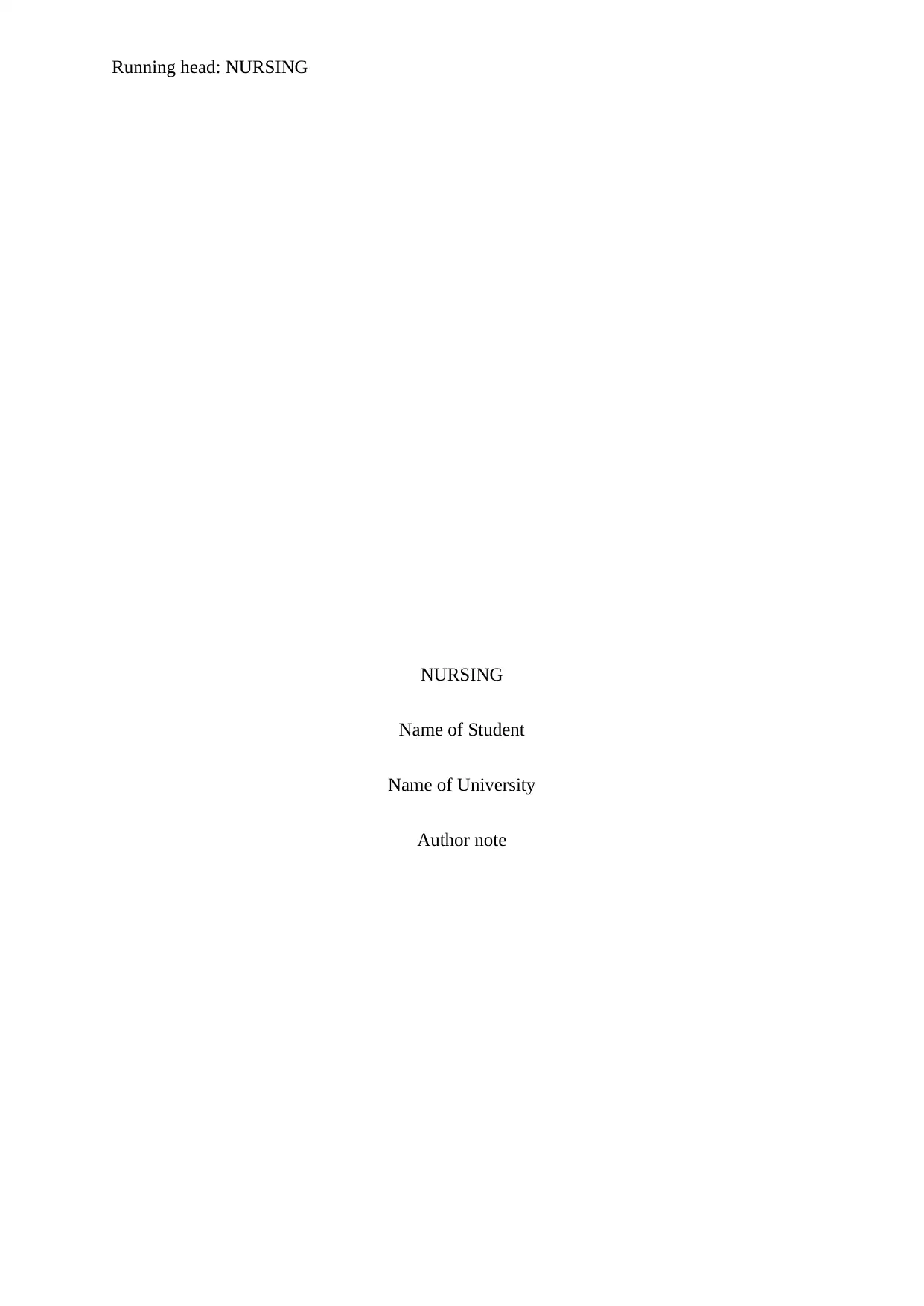
Running head: NURSING
NURSING
Name of Student
Name of University
Author note
NURSING
Name of Student
Name of University
Author note
Paraphrase This Document
Need a fresh take? Get an instant paraphrase of this document with our AI Paraphraser
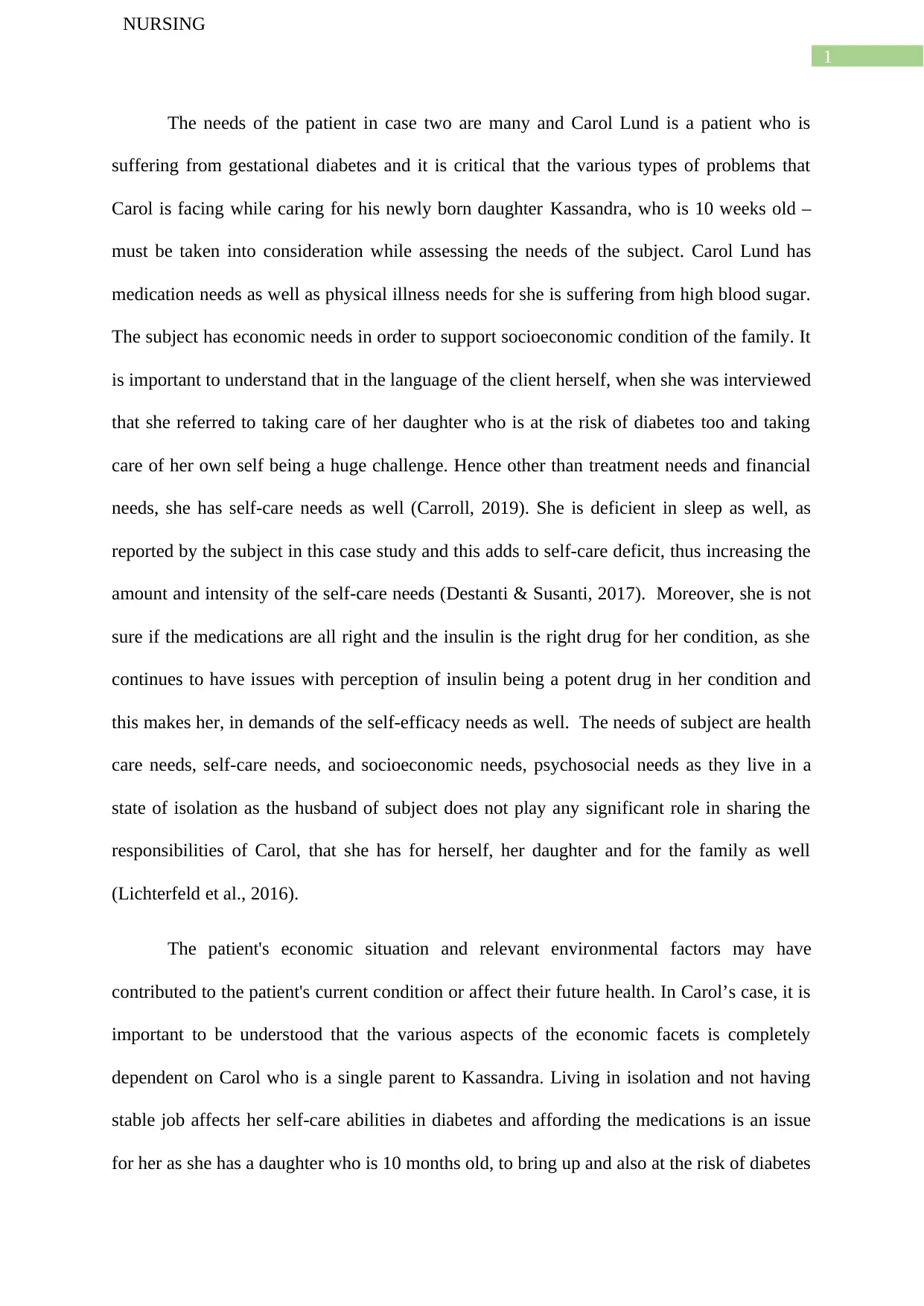
1
NURSING
The needs of the patient in case two are many and Carol Lund is a patient who is
suffering from gestational diabetes and it is critical that the various types of problems that
Carol is facing while caring for his newly born daughter Kassandra, who is 10 weeks old –
must be taken into consideration while assessing the needs of the subject. Carol Lund has
medication needs as well as physical illness needs for she is suffering from high blood sugar.
The subject has economic needs in order to support socioeconomic condition of the family. It
is important to understand that in the language of the client herself, when she was interviewed
that she referred to taking care of her daughter who is at the risk of diabetes too and taking
care of her own self being a huge challenge. Hence other than treatment needs and financial
needs, she has self-care needs as well (Carroll, 2019). She is deficient in sleep as well, as
reported by the subject in this case study and this adds to self-care deficit, thus increasing the
amount and intensity of the self-care needs (Destanti & Susanti, 2017). Moreover, she is not
sure if the medications are all right and the insulin is the right drug for her condition, as she
continues to have issues with perception of insulin being a potent drug in her condition and
this makes her, in demands of the self-efficacy needs as well. The needs of subject are health
care needs, self-care needs, and socioeconomic needs, psychosocial needs as they live in a
state of isolation as the husband of subject does not play any significant role in sharing the
responsibilities of Carol, that she has for herself, her daughter and for the family as well
(Lichterfeld et al., 2016).
The patient's economic situation and relevant environmental factors may have
contributed to the patient's current condition or affect their future health. In Carol’s case, it is
important to be understood that the various aspects of the economic facets is completely
dependent on Carol who is a single parent to Kassandra. Living in isolation and not having
stable job affects her self-care abilities in diabetes and affording the medications is an issue
for her as she has a daughter who is 10 months old, to bring up and also at the risk of diabetes
NURSING
The needs of the patient in case two are many and Carol Lund is a patient who is
suffering from gestational diabetes and it is critical that the various types of problems that
Carol is facing while caring for his newly born daughter Kassandra, who is 10 weeks old –
must be taken into consideration while assessing the needs of the subject. Carol Lund has
medication needs as well as physical illness needs for she is suffering from high blood sugar.
The subject has economic needs in order to support socioeconomic condition of the family. It
is important to understand that in the language of the client herself, when she was interviewed
that she referred to taking care of her daughter who is at the risk of diabetes too and taking
care of her own self being a huge challenge. Hence other than treatment needs and financial
needs, she has self-care needs as well (Carroll, 2019). She is deficient in sleep as well, as
reported by the subject in this case study and this adds to self-care deficit, thus increasing the
amount and intensity of the self-care needs (Destanti & Susanti, 2017). Moreover, she is not
sure if the medications are all right and the insulin is the right drug for her condition, as she
continues to have issues with perception of insulin being a potent drug in her condition and
this makes her, in demands of the self-efficacy needs as well. The needs of subject are health
care needs, self-care needs, and socioeconomic needs, psychosocial needs as they live in a
state of isolation as the husband of subject does not play any significant role in sharing the
responsibilities of Carol, that she has for herself, her daughter and for the family as well
(Lichterfeld et al., 2016).
The patient's economic situation and relevant environmental factors may have
contributed to the patient's current condition or affect their future health. In Carol’s case, it is
important to be understood that the various aspects of the economic facets is completely
dependent on Carol who is a single parent to Kassandra. Living in isolation and not having
stable job affects her self-care abilities in diabetes and affording the medications is an issue
for her as she has a daughter who is 10 months old, to bring up and also at the risk of diabetes
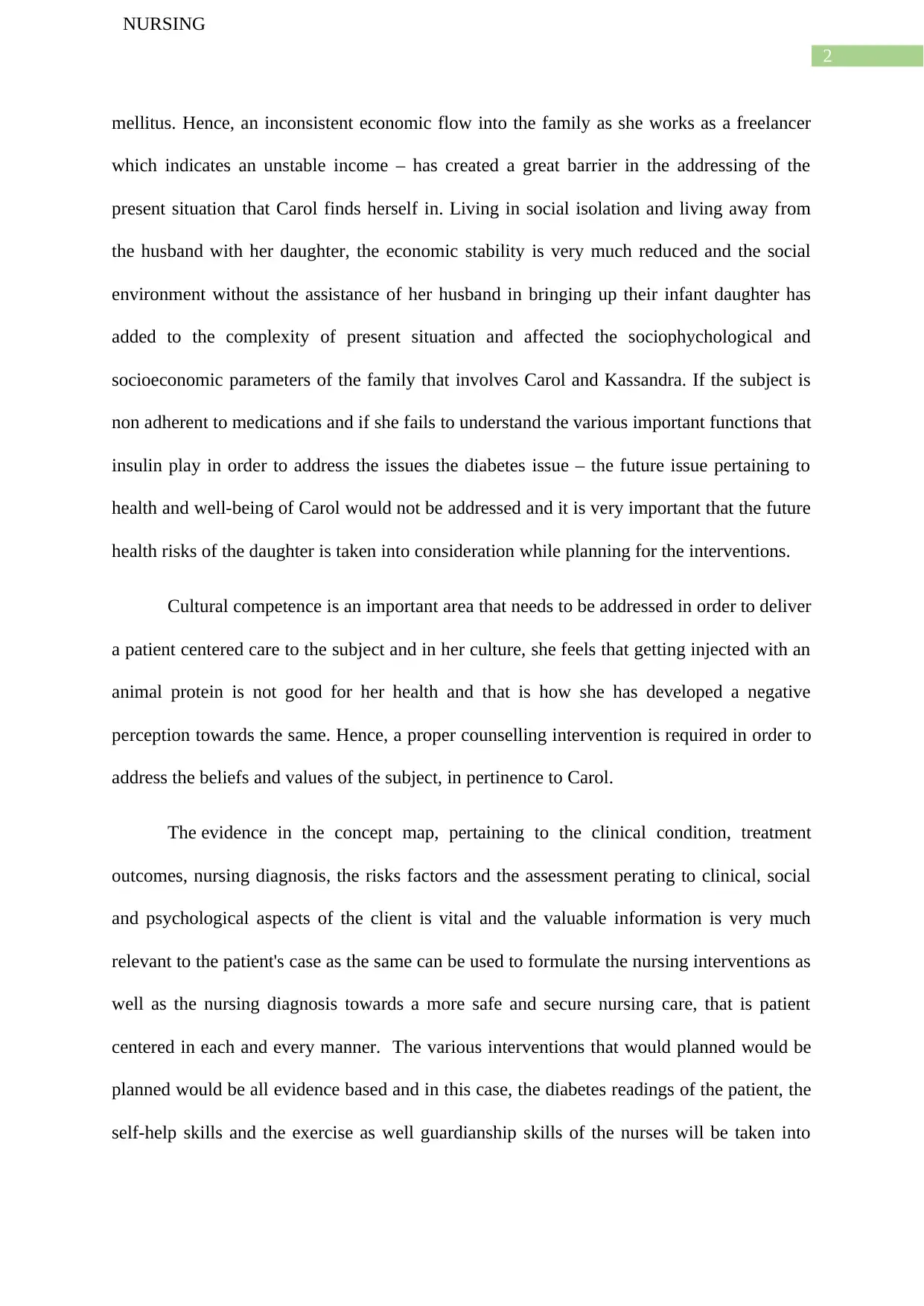
2
NURSING
mellitus. Hence, an inconsistent economic flow into the family as she works as a freelancer
which indicates an unstable income – has created a great barrier in the addressing of the
present situation that Carol finds herself in. Living in social isolation and living away from
the husband with her daughter, the economic stability is very much reduced and the social
environment without the assistance of her husband in bringing up their infant daughter has
added to the complexity of present situation and affected the sociophychological and
socioeconomic parameters of the family that involves Carol and Kassandra. If the subject is
non adherent to medications and if she fails to understand the various important functions that
insulin play in order to address the issues the diabetes issue – the future issue pertaining to
health and well-being of Carol would not be addressed and it is very important that the future
health risks of the daughter is taken into consideration while planning for the interventions.
Cultural competence is an important area that needs to be addressed in order to deliver
a patient centered care to the subject and in her culture, she feels that getting injected with an
animal protein is not good for her health and that is how she has developed a negative
perception towards the same. Hence, a proper counselling intervention is required in order to
address the beliefs and values of the subject, in pertinence to Carol.
The evidence in the concept map, pertaining to the clinical condition, treatment
outcomes, nursing diagnosis, the risks factors and the assessment perating to clinical, social
and psychological aspects of the client is vital and the valuable information is very much
relevant to the patient's case as the same can be used to formulate the nursing interventions as
well as the nursing diagnosis towards a more safe and secure nursing care, that is patient
centered in each and every manner. The various interventions that would planned would be
planned would be all evidence based and in this case, the diabetes readings of the patient, the
self-help skills and the exercise as well guardianship skills of the nurses will be taken into
NURSING
mellitus. Hence, an inconsistent economic flow into the family as she works as a freelancer
which indicates an unstable income – has created a great barrier in the addressing of the
present situation that Carol finds herself in. Living in social isolation and living away from
the husband with her daughter, the economic stability is very much reduced and the social
environment without the assistance of her husband in bringing up their infant daughter has
added to the complexity of present situation and affected the sociophychological and
socioeconomic parameters of the family that involves Carol and Kassandra. If the subject is
non adherent to medications and if she fails to understand the various important functions that
insulin play in order to address the issues the diabetes issue – the future issue pertaining to
health and well-being of Carol would not be addressed and it is very important that the future
health risks of the daughter is taken into consideration while planning for the interventions.
Cultural competence is an important area that needs to be addressed in order to deliver
a patient centered care to the subject and in her culture, she feels that getting injected with an
animal protein is not good for her health and that is how she has developed a negative
perception towards the same. Hence, a proper counselling intervention is required in order to
address the beliefs and values of the subject, in pertinence to Carol.
The evidence in the concept map, pertaining to the clinical condition, treatment
outcomes, nursing diagnosis, the risks factors and the assessment perating to clinical, social
and psychological aspects of the client is vital and the valuable information is very much
relevant to the patient's case as the same can be used to formulate the nursing interventions as
well as the nursing diagnosis towards a more safe and secure nursing care, that is patient
centered in each and every manner. The various interventions that would planned would be
planned would be all evidence based and in this case, the diabetes readings of the patient, the
self-help skills and the exercise as well guardianship skills of the nurses will be taken into
⊘ This is a preview!⊘
Do you want full access?
Subscribe today to unlock all pages.

Trusted by 1+ million students worldwide
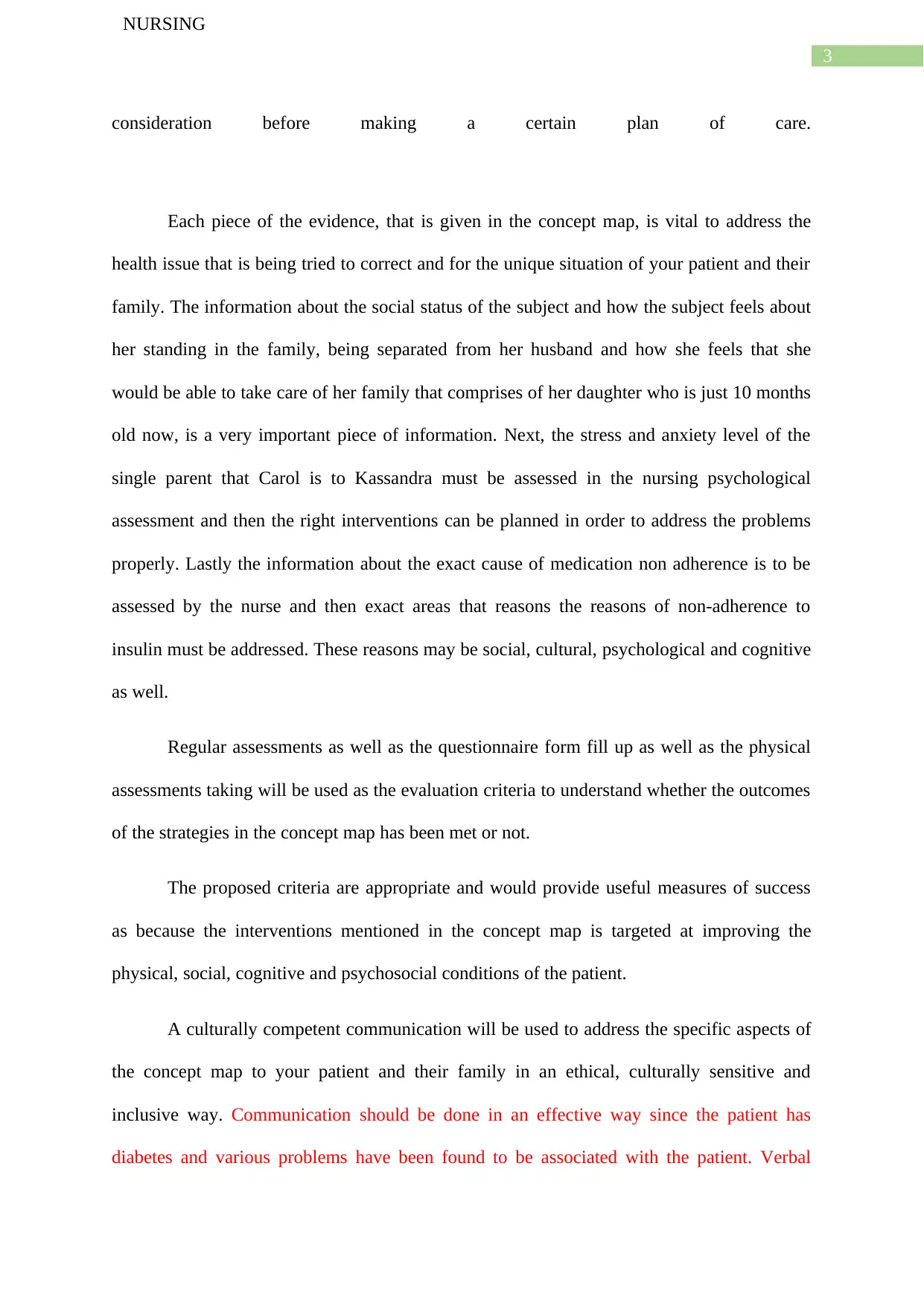
3
NURSING
consideration before making a certain plan of care.
Each piece of the evidence, that is given in the concept map, is vital to address the
health issue that is being tried to correct and for the unique situation of your patient and their
family. The information about the social status of the subject and how the subject feels about
her standing in the family, being separated from her husband and how she feels that she
would be able to take care of her family that comprises of her daughter who is just 10 months
old now, is a very important piece of information. Next, the stress and anxiety level of the
single parent that Carol is to Kassandra must be assessed in the nursing psychological
assessment and then the right interventions can be planned in order to address the problems
properly. Lastly the information about the exact cause of medication non adherence is to be
assessed by the nurse and then exact areas that reasons the reasons of non-adherence to
insulin must be addressed. These reasons may be social, cultural, psychological and cognitive
as well.
Regular assessments as well as the questionnaire form fill up as well as the physical
assessments taking will be used as the evaluation criteria to understand whether the outcomes
of the strategies in the concept map has been met or not.
The proposed criteria are appropriate and would provide useful measures of success
as because the interventions mentioned in the concept map is targeted at improving the
physical, social, cognitive and psychosocial conditions of the patient.
A culturally competent communication will be used to address the specific aspects of
the concept map to your patient and their family in an ethical, culturally sensitive and
inclusive way. Communication should be done in an effective way since the patient has
diabetes and various problems have been found to be associated with the patient. Verbal
NURSING
consideration before making a certain plan of care.
Each piece of the evidence, that is given in the concept map, is vital to address the
health issue that is being tried to correct and for the unique situation of your patient and their
family. The information about the social status of the subject and how the subject feels about
her standing in the family, being separated from her husband and how she feels that she
would be able to take care of her family that comprises of her daughter who is just 10 months
old now, is a very important piece of information. Next, the stress and anxiety level of the
single parent that Carol is to Kassandra must be assessed in the nursing psychological
assessment and then the right interventions can be planned in order to address the problems
properly. Lastly the information about the exact cause of medication non adherence is to be
assessed by the nurse and then exact areas that reasons the reasons of non-adherence to
insulin must be addressed. These reasons may be social, cultural, psychological and cognitive
as well.
Regular assessments as well as the questionnaire form fill up as well as the physical
assessments taking will be used as the evaluation criteria to understand whether the outcomes
of the strategies in the concept map has been met or not.
The proposed criteria are appropriate and would provide useful measures of success
as because the interventions mentioned in the concept map is targeted at improving the
physical, social, cognitive and psychosocial conditions of the patient.
A culturally competent communication will be used to address the specific aspects of
the concept map to your patient and their family in an ethical, culturally sensitive and
inclusive way. Communication should be done in an effective way since the patient has
diabetes and various problems have been found to be associated with the patient. Verbal
Paraphrase This Document
Need a fresh take? Get an instant paraphrase of this document with our AI Paraphraser
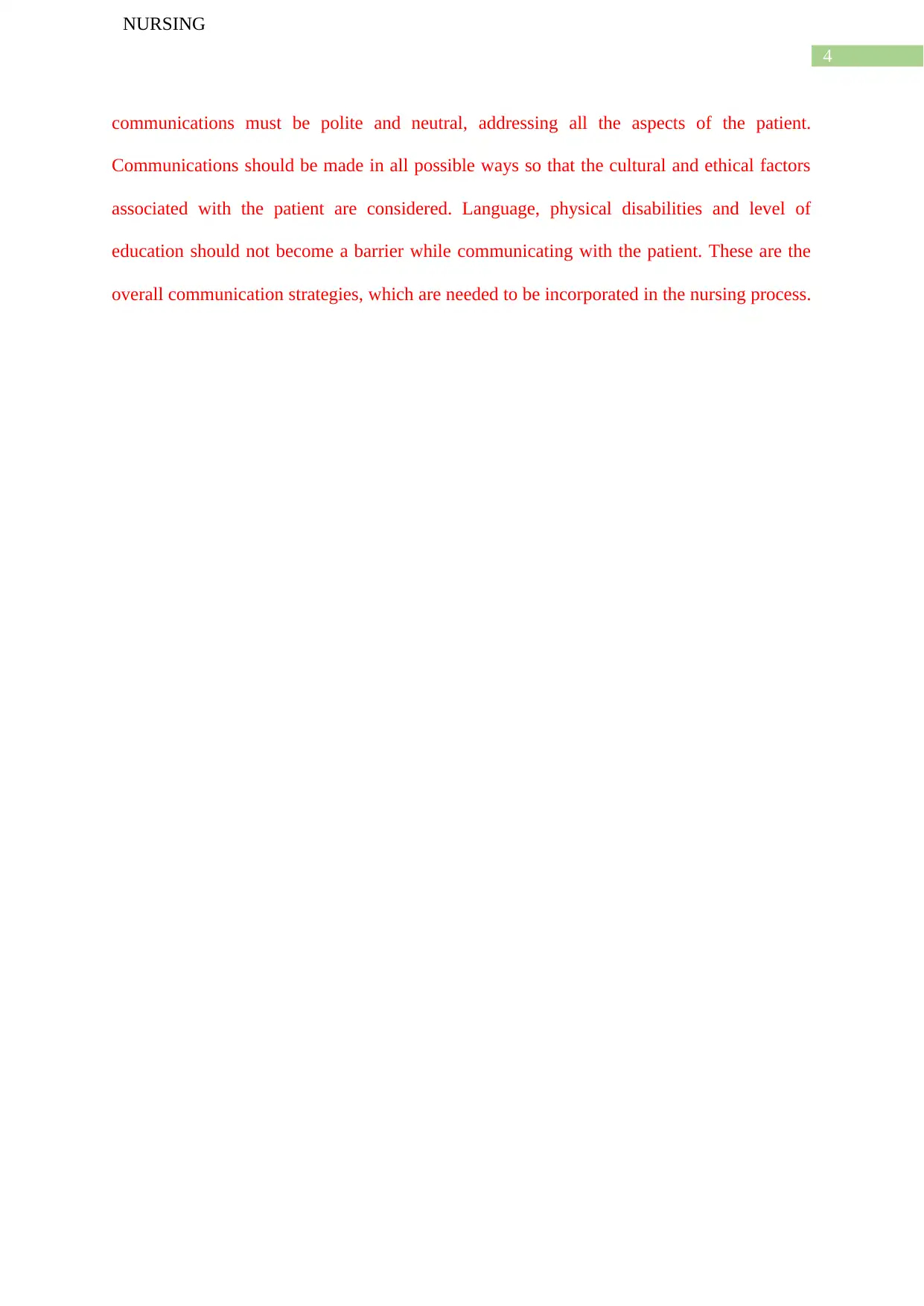
4
NURSING
communications must be polite and neutral, addressing all the aspects of the patient.
Communications should be made in all possible ways so that the cultural and ethical factors
associated with the patient are considered. Language, physical disabilities and level of
education should not become a barrier while communicating with the patient. These are the
overall communication strategies, which are needed to be incorporated in the nursing process.
NURSING
communications must be polite and neutral, addressing all the aspects of the patient.
Communications should be made in all possible ways so that the cultural and ethical factors
associated with the patient are considered. Language, physical disabilities and level of
education should not become a barrier while communicating with the patient. These are the
overall communication strategies, which are needed to be incorporated in the nursing process.
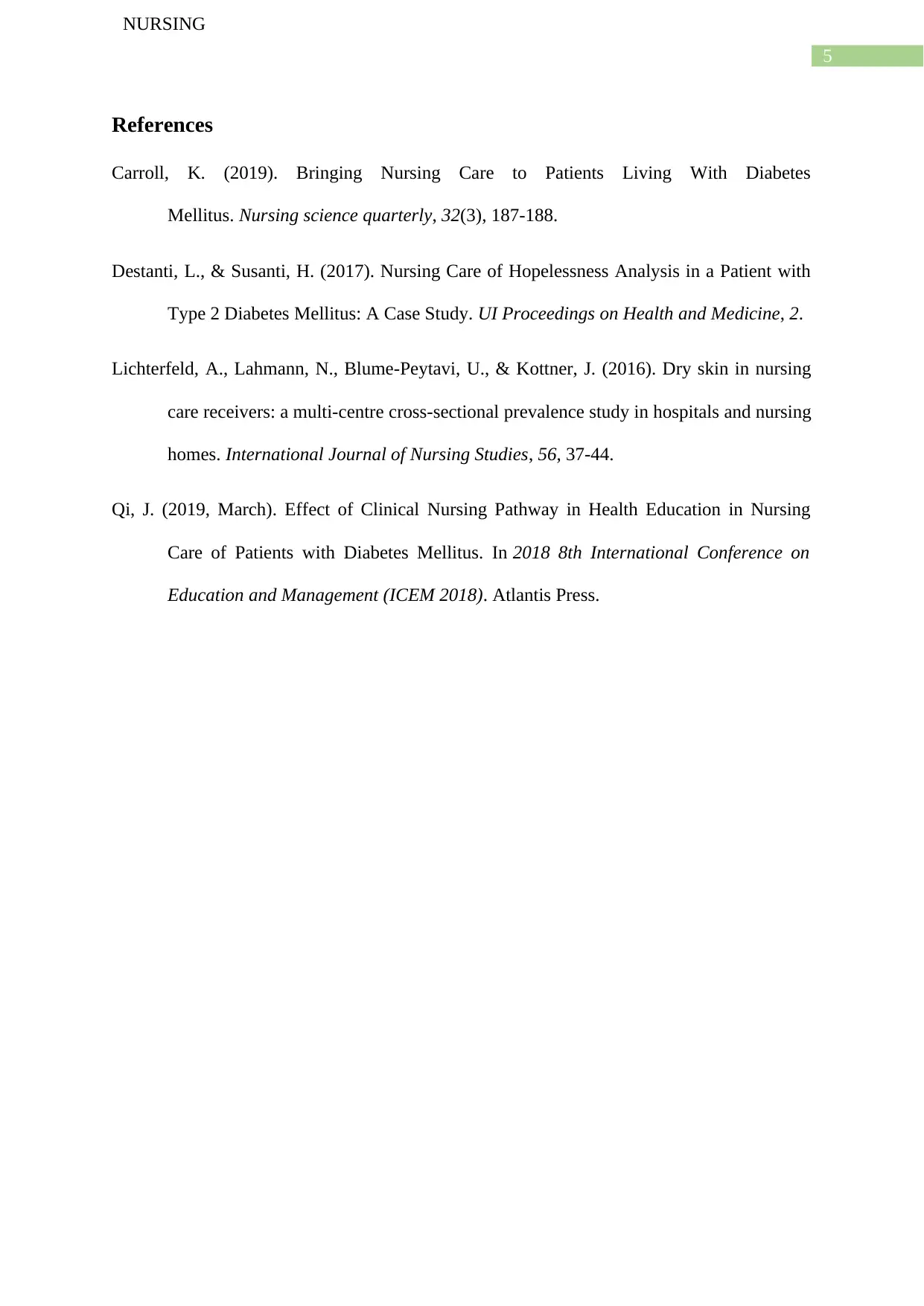
5
NURSING
References
Carroll, K. (2019). Bringing Nursing Care to Patients Living With Diabetes
Mellitus. Nursing science quarterly, 32(3), 187-188.
Destanti, L., & Susanti, H. (2017). Nursing Care of Hopelessness Analysis in a Patient with
Type 2 Diabetes Mellitus: A Case Study. UI Proceedings on Health and Medicine, 2.
Lichterfeld, A., Lahmann, N., Blume-Peytavi, U., & Kottner, J. (2016). Dry skin in nursing
care receivers: a multi-centre cross-sectional prevalence study in hospitals and nursing
homes. International Journal of Nursing Studies, 56, 37-44.
Qi, J. (2019, March). Effect of Clinical Nursing Pathway in Health Education in Nursing
Care of Patients with Diabetes Mellitus. In 2018 8th International Conference on
Education and Management (ICEM 2018). Atlantis Press.
NURSING
References
Carroll, K. (2019). Bringing Nursing Care to Patients Living With Diabetes
Mellitus. Nursing science quarterly, 32(3), 187-188.
Destanti, L., & Susanti, H. (2017). Nursing Care of Hopelessness Analysis in a Patient with
Type 2 Diabetes Mellitus: A Case Study. UI Proceedings on Health and Medicine, 2.
Lichterfeld, A., Lahmann, N., Blume-Peytavi, U., & Kottner, J. (2016). Dry skin in nursing
care receivers: a multi-centre cross-sectional prevalence study in hospitals and nursing
homes. International Journal of Nursing Studies, 56, 37-44.
Qi, J. (2019, March). Effect of Clinical Nursing Pathway in Health Education in Nursing
Care of Patients with Diabetes Mellitus. In 2018 8th International Conference on
Education and Management (ICEM 2018). Atlantis Press.
⊘ This is a preview!⊘
Do you want full access?
Subscribe today to unlock all pages.

Trusted by 1+ million students worldwide
1 out of 6
Related Documents
Your All-in-One AI-Powered Toolkit for Academic Success.
+13062052269
info@desklib.com
Available 24*7 on WhatsApp / Email
![[object Object]](/_next/static/media/star-bottom.7253800d.svg)
Unlock your academic potential
Copyright © 2020–2025 A2Z Services. All Rights Reserved. Developed and managed by ZUCOL.





